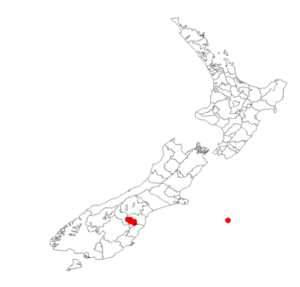Carmichaelia hollowayi facts for kids
Quick facts for kids Carmichaelia hollowayi |
|
|---|---|
| Conservation status | |
 Nationally Critical (NZ TCS) |
|
| Scientific classification | |
| Kingdom: | |
| (unranked): | |
| (unranked): | |
| (unranked): | |
| Order: | |
| Family: | |
| Genus: | |
| Species: |
C. hollowayi
|
| Binomial name | |
| Carmichaelia hollowayi G.Simpson
|
|
 |
|
| Occurrence data from AVH | |
Carmichaelia hollowayi is a special plant known as Holloways broom. It's a type of legume or pea plant, belonging to the Fabaceae family. This unique shrub is found only in the South Island of New Zealand. Sadly, it's considered "Nationally Critical," which means it's very close to disappearing forever.
Contents
What Does Holloways Broom Look Like?
C. hollowayi is a small shrub, usually growing about 50 to 60 centimeters (about 20-24 inches) tall. When it first starts to grow, its stems stand upright. But as the plant gets older, its stems begin to trail and spread out across the ground. This makes it a low-growing plant that can cover a good amount of space.
Where Does Holloways Broom Live?
This plant prefers to grow on limestone rock. Limestone is a type of rock that forms from the shells and skeletons of tiny sea creatures. It's a special kind of environment that only certain plants can thrive in.
Why is Holloways Broom Important?
Its Conservation Status
In 2018, experts looked at C. hollowayi and decided its conservation status was "Nationally Critical." This is the highest level of threat under the New Zealand Threat Classification System. It means the plant is facing an extremely high risk of dying out in the wild. Protecting these plants is very important to keep New Zealand's unique nature safe.
How Was Holloways Broom Discovered?
Naming the Species
The plant was first officially described by a botanist named George Simpson in 1945. To "describe" a species means to give it a scientific name and write down all its features. This helps scientists around the world know exactly which plant they are talking about.
Early Records
The earliest known sample of C. hollowayi was collected by George Simpson himself in 1937. This sample is now kept in a special collection called the AVH. It helps scientists study the plant even today.

